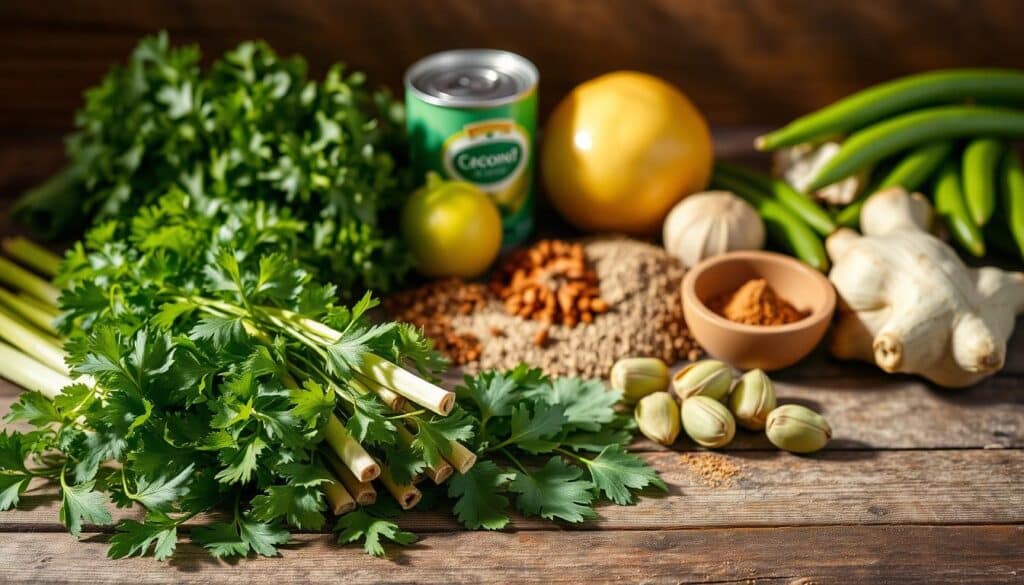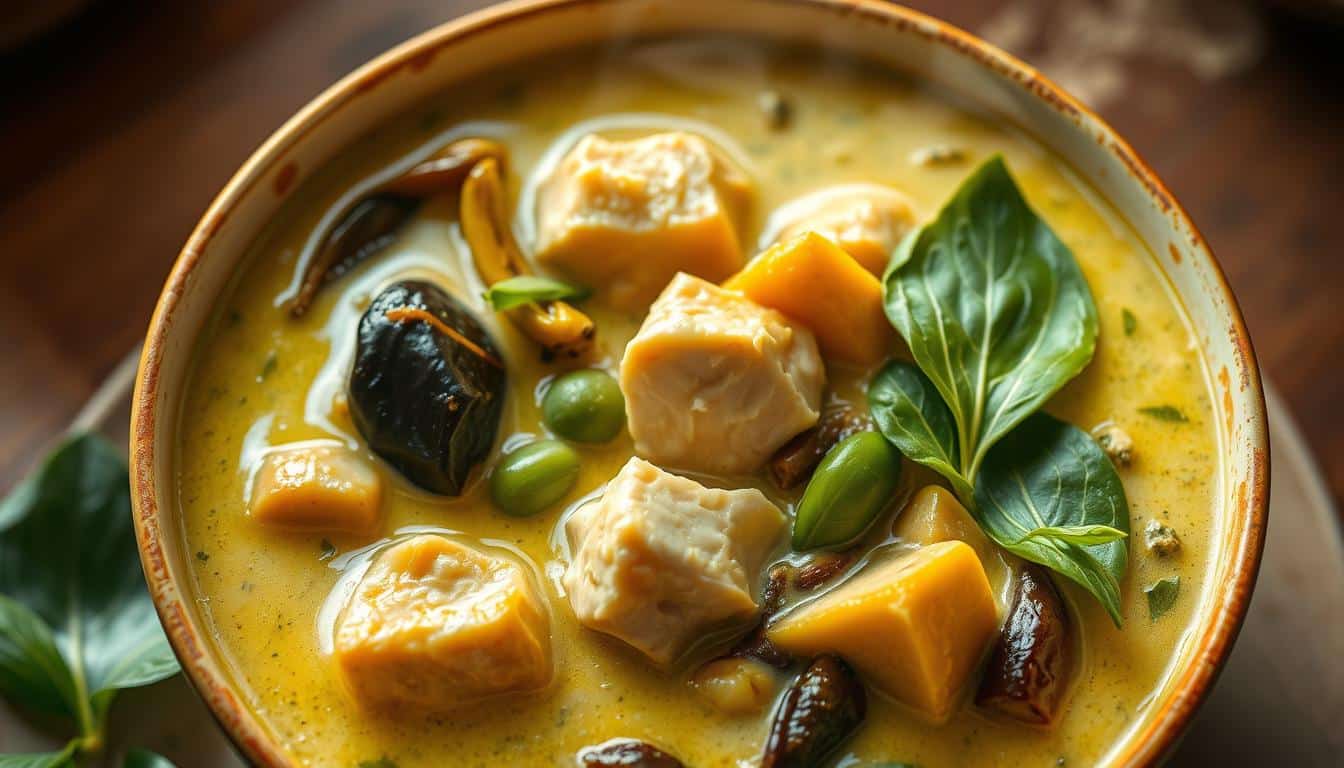I still remember my first encounter with Thai cuisine—it was nothing short of magical. Among the myriad of dishes I tried, one stood out: green curry. The creamy coconut milk, the vibrant heat from the curry paste, and the freshness of the vegetables created a symphony of flavors that left me enchanted. Since then, I’ve been on a journey to master this dish, exploring both store-bought and homemade curry pastes to achieve that authentic Thai taste.
Thank you for reading this post, don't forget to subscribe!What I love most about green curry is its accessibility. Whether you’re using a store-bought paste for convenience or crafting your own from scratch, the result is a dish that feels both exotic and comforting. The combination of coconut milk and green curry paste creates a rich, velvety texture that coats your taste buds, while the fresh vegetables add a delightful crunch and burst of color.
In this article, I’ll guide you through a step-by-step curry recipe that balances ease with authenticity. We’ll explore the essential ingredients, from the aromatic herbs to the variety of vegetables you can customize. By the end of this journey, you’ll be equipped to create a restaurant-quality green curry in the comfort of your own kitchen.

Key Takeaways
- Green curry can be easily made with store-bought or homemade curry paste for authentic flavor.
- The dish is highly customizable, allowing you to use a variety of colorful vegetables.
- Quality ingredients, like fresh herbs and full-fat coconut milk, elevate the dish to restaurant quality.
- Green curry is ready in under 40 minutes, making it a quick and flavorful meal option.
- The recipe serves 4 and can be paired with jasmine rice for a complete meal.
- It’s gluten-free and vegan-friendly, suitable for various dietary preferences.
Ready to embark on this flavorful journey? Let’s dive into the world of green curry and uncover the secrets to making it perfectly every time. Whether you’re a seasoned cook or a culinary newbie, this curry recipe promises to delight your senses and leave you craving for more.
For more recipe inspiration, check out this vegetable Thai green curry or explore a different flavor profile with this chicken in tomato sauce recipe.
Introduction: My Journey to Thai Green Curry
My adventure with Thai cuisine began during a trip to Bangkok, where the vibrant streets and aromatic markets captivated my senses. It was there that I first tasted Thai green curry, and it was love at first bite. The harmony of spicy chilies, creamy coconut milk, and fresh herbs left an indelible mark on my palate, inspiring me to delve deeper into this iconic dish.
As I explored more of Thailand, I realized the heart of Thai cuisine lies in its balance of flavors and the use of fresh, high-quality ingredients. This understanding shaped my approach to cooking Thai green curry, teaching me the importance of carefully selecting each component to achieve that perfect harmony.
My journey led me to experiment with various ingredients and techniques, from roasting spices to blending aromatic herbs. This experimentation not only refined my recipe but also deepened my appreciation for the cultural richness behind Thai green curry. Sharing this journey with you is a delight, as I hope it will inspire you to create your own memorable dishes.
| Component | Importance | Tips |
|---|---|---|
| Green Chilies | Provides the signature heat | Use fresh for best flavor |
| Coconut Milk | Creates creamy texture | Opt for full-fat for richness |
| Aromatic Herbs | Enhances aroma and depth | Fresh herbs like lemongrass and galangal are ideal |
| Vegetables | Adds texture and color | Customize with your favorites |
Green Curry: A curry made with coconut milk, green curry paste, and vegetables.
At the heart of every great green curry lies a harmonious blend of ingredients, with coconut milk playing a starring role. This creamy element isn’t just about texture; it’s the foundation that balances the bold, spicy notes of the curry paste.
Using full-fat coconut milk is non-negotiable for an authentic taste. It brings a richness that lighter versions simply can’t match, ensuring the curry isn’t just creamy but also deeply flavorful. When you combine this with high-quality curry paste, the result is nothing short of magical.
But it’s not just about the coconut milk and paste. High-quality oil is essential for sautéing aromatics, creating the perfect base for the curry. This step is crucial for bringing out the depth of flavor in the paste and ensuring the coconut milk melds seamlessly into the sauce.
When all these elements come together, they form the signature taste of green curry that we all love. It’s a balance of spicy, savory, and creamy that keeps us coming back for more. For a delicious and authentic recipe, check out this green Thai chicken coconut curry recipe.
Ingredient Essentials for a Perfect Green Curry
Creating an authentic green curry starts with selecting the right ingredients. Freshness and quality are key to achieving that vibrant, balanced flavor we all love.
Fresh Vegetables and Aromatics
Fresh vegetables add both texture and color to the dish. I prefer using a mix of bell peppers, zucchini, and snap peas for their crunch and visual appeal. Aromatics like lemongrass and galangal are essential for depth. These ingredients create the aromatic foundation that defines Thai green curry.
Signature Ingredients: Curry Paste and Coconut Milk
The heart of the dish lies in the curry paste and coconut milk. I recommend using full-fat coconut milk for its rich, creamy texture. High-quality curry paste ensures bold, authentic flavor. Together, they form the sauce that brings everything together.
- Tofu is my go-to protein for a vegan twist. It absorbs the curry sauce beautifully when prepared correctly.
- Customize with your favorite vegetables for a personalized touch.
- Measure ingredients like coconut milk and curry paste by the cup for consistency.
- Quality ingredients are non-negotiable for an authentic experience.
Experiment with colorful vegetables and protein options to make each batch unique. The right ingredients will elevate your green curry to new heights!

Step-by-Step Instructions for a Flavorful Thai Curry
Cooking Thai curry is an art that combines simplicity with flavor. Let me guide you through each step to create a dish that’s both delicious and authentic.
Prepping Tofu and Vegetables
Start by preparing your tofu. Cut it into bite-sized cubes and press it to remove excess moisture. For added texture, boil the tofu in salted water for about 5 minutes. While the tofu cooks, chop your vegetables. Bell peppers, zucchini, and snap peas work well. Keep them colorful and crisp for the best texture.
Building the Rich Curry Sauce
In a hot pan, pour in 2 tablespoons of oil. Add 4-6 tablespoons of curry paste and sauté for 1-2 minutes until fragrant. Stir in 400g of full-fat coconut milk and bring to a simmer. Let it cook for 5 minutes to thicken, stirring occasionally. Add your prepped vegetables and tofu, then reduce the heat. Let everything simmer for 10-15 minutes to meld the flavors together.
| Component | Role | Tips |
|---|---|---|
| Tofu | Protein source | Press and boil for better texture |
| Vegetables | Texture and color | Use crunchy, colorful options |
| Curry Paste | Flavor base | Use 4-6 tablespoons for rich taste |
| Coconut Milk | Creamy sauce | Opt for full-fat |
By following these steps, you’ll achieve a perfectly balanced Thai curry. Enjoy your culinary creation!
Tips and Techniques for Restaurant-Quality Green Curry
One of the most rewarding aspects of cooking Thai green curry is the ability to tailor it to your taste preferences. I’ve found that mastering the balance between spicy heat and sweet, tangy notes can elevate the dish to new heights.
Balancing Flavors and Adjusting Spice Levels
To achieve that perfect harmony, start by tasting as you go. Adjust the heat by adding more curry paste gradually. Remember, you can always add more heat, but it’s harder to take it away once added. Pair the spiciness with a touch of coconut sugar for sweetness and a squeeze of fresh lime for acidity. This balance creates a dish that’s both exciting and refined.
When it comes to cooking time, don’t rush the process. Simmering the curry for about 10-15 minutes allows the flavors to meld together beautifully. If the sauce becomes too thick, a splash of water or additional coconut milk can adjust the consistency to your liking.
Trust your instincts and don’t be afraid to experiment. The key to a great curry is layering flavors—from the bold heat of the paste to the bright freshness of herbs. By following these tips, you’ll create a dish that feels truly special, every time.
Store-Bought vs. Homemade Curry Paste: Making the Right Choice
When it comes to preparing Thai green curry, one of the most important decisions is whether to use store-bought or homemade curry paste. Both options have their merits, and the choice often comes down to convenience, flavor preference, and the time you have available.
When to Use Homemade Thai Green Curry Paste
Homemade curry paste offers unparalleled freshness and depth of flavor. If you have the time and access to fresh ingredients like lemongrass and galangal, making your own paste is highly rewarding. It allows you to customize the flavor profile and ensure it aligns with your dietary preferences, such as being vegan-friendly.
On the other hand, store-bought curry paste is a convenient option for busy schedules. Brands like Maesri and Aroy-D provide excellent flavor with minimal prep. Aroy-D is particularly noted for being vegan-friendly, making it a great choice for those with dietary restrictions.
| Feature | Store-Bought | Homemade |
|---|---|---|
| Convenience | Quick and easy to use | Requires time to prepare |
| Flavor | Consistent but may lack depth | Rich and customizable |
| Cost | Generally affordable | Can be more expensive |
| Customization | Limited to brand offerings | Highly customizable |
When using store-bought paste, a splash of water can help deglaze the pan and incorporate the paste evenly, enhancing the overall sauce texture. Experiment with different brands to find the one that suits your taste best.

Creative Serving Suggestions and Plating Ideas
The presentation of your green curry can transform it from a simple home-cooked meal to a restaurant-worthy dish. Creative serving and plating ideas not only enhance the visual appeal but also elevate the overall dining experience.
Pairing with Rice and Noodles
One of the most popular ways to enjoy green curry is over a bed of fluffy jasmine rice. The creamy sauce coats the rice perfectly, creating a delicious harmony of flavors. For a lighter option, try serving it with rice noodles or even quinoa for a nutritious twist.
When it comes to plating, a few simple touches can make a big difference. Drizzle a bit of fresh lime juice over the top for a burst of citrus flavor. Sprinkle some chopped Thai basil or regular basil for a fragrant and colorful finish. These small details can make your dish look and taste like it was prepared by a professional chef.
- Serve over jasmine rice for a classic presentation.
- Pair with rice noodles for a lighter meal.
- Add a sprinkle of Thai basil or regular basil for freshness.
- Drizzle with fresh lime juice for a touch of acidity.
- Garnish with chopped cashews for added texture.
Remember, the key to a great presentation is balance and freshness. Use colorful vegetables and fresh herbs to make your green curry visually appealing. Whether you’re serving it at home or for a special occasion, these creative ideas will make your dish stand out and leave a lasting impression on your guests.
Exploring Tofu Variations and Cooking Methods
Tofu is a versatile protein that can be prepared in multiple ways to enhance both texture and flavor in your curry. Whether you prefer it soft, crispy, or evenly browned, there’s a method to suit your taste.
Boiling, Pan-Frying, and Baking Tofu
Boiling tofu in salted water is a great way to add moisture and subtle flavor. This method keeps the tofu tender and is perfect for absorbing the rich flavors of the curry sauce.
Pan-frying, on the other hand, creates a crispy exterior while keeping the inside soft. Lightly seasoning the tofu with a pinch of pepper and a touch of sugar before pan-frying balances the savory flavors and adds a nice caramelized crust.
Baking tofu in the oven offers even browning and a firmer texture. Simply cut the tofu into cubes, season lightly, and bake until golden. This method is ideal for those who prefer a healthier, less oily option.
Using a light broth during cooking can enhance moisture and infuse extra flavor. Experiment with these methods to find your favorite way to prepare tofu, making each curry dish uniquely yours.
For more recipe ideas, check out this pasta recipe for a different culinary adventure.
Conclusion
Making Thai green curry at home is a delightful experience that combines simplicity with rich, authentic flavors. By following the steps and tips shared throughout this article, you can easily create a dish that’s both nourishing and delicious. Remember, the key to a great green curry lies in its balance of spicy and creamy elements, along with the freshness of its ingredients.
Don’t hesitate to get creative! Try experimenting with different types of bell peppers or even adding a twist with potato for a unique variation. Your kitchen is your canvas, and every adjustment brings a new dimension to the dish. I’d love to hear about your experiences—leave a comment below and share any tips or tweaks that worked well for you.
Great food is more than just a meal; it’s a reflection of passion and creativity. So, go ahead, give this green curry recipe a try, and let the flavors transport you to the heart of Thai cuisine. Happy cooking!
FAQ
How long does it take to make Thai Green Curry from scratch?
It typically takes about 30-40 minutes, including prep time. The actual cooking time is around 15-20 minutes once all ingredients are ready.
Can I use store-bought curry paste instead of homemade?
Absolutely! Store-bought curry paste is a convenient option and works well for a quick, flavorful dish. Look for a reputable brand like Thai Kitchen or Mae Ploy for the best results.
How do I adjust the heat level in Thai Green Curry?
To make it milder, use less curry paste or omit the chili peppers. For more heat, add fresh Thai chilies or a dash of hot sauce to taste.
What are the best vegetables to add to Thai Green Curry?
Bell peppers, Thai basil, bamboo shoots, and your choice of protein like tofu or chicken are classic additions. Feel free to customize with veggies like zucchini or carrots for extra flavor and texture.
Can I make Thai Green Curry without coconut milk?
While coconut milk is essential for the creamy texture, you can substitute it with a non-dairy milk like almond or oat milk for a lighter version. Note that the flavor will be slightly different.
How do I ensure the curry sauce is rich and creamy?
Stir in a tablespoon of oil before adding the curry paste to help release its flavors. Gradually mix in the coconut milk, and let it simmer until the sauce thickens naturally.
Can I cook tofu ahead of time for the curry?
Yes, you can pan-fry or bake tofu in advance. Let it cool, then refrigerate or store it in an airtight container for up to a day before adding it to the curry.
What’s the best way to serve Thai Green Curry?
Serve it over a bed of fluffy jasmine rice or with fresh noodles for a complete meal. Garnish with fresh basil leaves and a sprinkle of chili flakes for added presentation.
How do I store leftover Thai Green Curry?
Let it cool completely, then transfer it to an airtight container and refrigerate for up to 3 days. You can also freeze it for up to 2 months. Reheat gently over low heat, adding a splash of water or broth if needed.
Is Thai Green Curry suitable for a vegetarian or vegan diet?
Yes, as long as you use plant-based ingredients. Ensure your curry paste and broth are free from animal products, and skip any fish sauce or shrimp paste for a vegan-friendly version.
Can I make Thai Green Curry in advance?
While it’s best served fresh, you can prepare the curry paste and chop the vegetables ahead of time. Cook the curry just before serving for the most vibrant flavors.
What’s the secret to a flavorful Thai Green Curry?
Balance is key! Combine the richness of coconut milk, the brightness of fresh herbs like basil and lime leaves, and the boldness of the curry paste for an authentic taste.
There are no reviews yet. Be the first one to write one.

